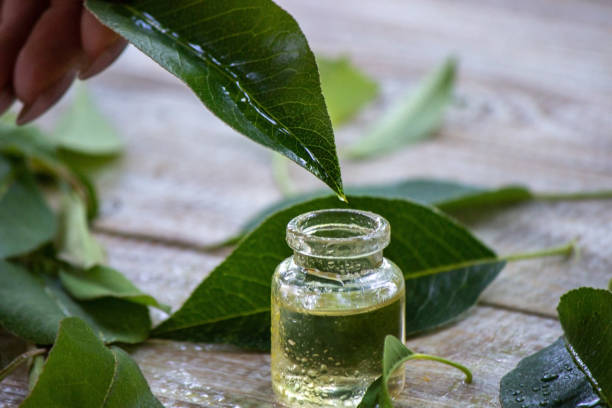Fungal nail infections, medically known as onychomycosis, can be a stubborn and unsightly problem that affects millions of people worldwide. These infections are often challenging to treat and can cause discomfort, embarrassment, and a reduced quality of life.
While there are various treatments available, many individuals are turning to natural remedies, such as tea tree oil, to combat fungal nails.

Tea tree oil, derived from the leaves of the Melaleuca alternifolia tree native to Australia, is renowned for its potent antifungal and antimicrobial properties. In this comprehensive guide, we will explore how to use tea tree oil effectively to treat fungal nails, providing you with the information and techniques needed to restore healthy, clear nails.
To know more about tea tree oil for nail fungus, just continue reading the content below.
Understanding Fungal Nail Infections
Before delving into the use of tea tree oil as a treatment for fungal nails, it is crucial to have a basic understanding of what fungal nail infections are and how they develop.
What Are Fungal Nail Infections?
Fungal nail infections are primarily caused by a group of fungi called dermatophytes. These fungi thrive in warm, moist environments, making toenails especially susceptible due to the conditions often found inside shoes and socks. Fungal nail infections can also be caused by yeast or mould.
Symptoms of fungal nail infections include:
- Thickened nails
- Discolouration (often yellow or brown)
- Brittleness
- Crumbling or jagged edges
- Distorted nail shape
- Foul odour
- Pain or discomfort
Causes and Risk Factors
Several factors can increase the risk of developing fungal nail infections:
- Age: Older individuals are more susceptible to fungal nail infections due to slower nail growth and reduced blood circulation.
- Weakened Immune System: Conditions like diabetes or immune system disorders can make you more prone to fungal infections.
- Nail Trauma: Injury to the nail or surrounding skin can create entry points for fungi.
- Warm, Humid Environments: Fungi thrive in moist conditions, which is why toenails are more commonly affected.
- Footwear: Tight, poorly ventilated shoes can create an ideal environment for fungal growth.
- Public Spaces: Walking barefoot in public showers, swimming pools, or gym locker rooms can increase the risk of exposure to fungi.
Now that we have a foundational understanding of fungal nail infections, let’s explore how tea tree oil can be used as a natural remedy to combat this common problem.
The Power of Tea Tree Oil
Tea tree oil, also known as melaleuca oil, has been used for centuries by Indigenous Australians for its medicinal properties. It gained popularity in the broader world of alternative medicine due to its impressive antifungal, antibacterial, and anti-inflammatory properties. Here’s why tea tree oil is a promising option for treating fungal nails:
- Antifungal Properties: Tea tree oil contains compounds like terpinen-4-ol, which have potent antifungal activity. These compounds can help inhibit the growth of fungi responsible for nail infections.
- Antimicrobial Action: Beyond its antifungal properties, tea tree oil is also effective against various bacteria and viruses, which can be beneficial if your fungal nail infection is accompanied by other issues.
- Anti-Inflammatory Effects: Tea tree oil can help reduce inflammation and itching, providing relief from the discomfort associated with fungal nail infections.
- Non-Toxic and Natural: Unlike some pharmaceutical antifungal treatments, tea tree oil is a natural remedy with minimal side effects when used correctly.
- Accessibility: Tea tree oil is readily available in most health food stores, pharmacies, and online, making it accessible for those seeking an alternative treatment.
Now that you understand why tea tree oil is a valuable option for addressing fungal nails, let’s explore how to use it effectively.
Using Tea Tree Oil for Fungal Nails
When using tea tree oil to treat fungal nails, it’s essential to follow a consistent and appropriate regimen. Here’s a step-by-step guide on how to use tea tree oil effectively for this purpose:
Step 1: Gather Your Supplies
Before you begin treatment, ensure you have the following items:
- Tea tree oil
- A carrier oil (e.g., olive oil, coconut oil)
- A clean nail file or clippers
- A cotton ball or swab
- A small dish for mixing
Step 2: Prepare the Infused Oil
Tea tree oil is highly concentrated and can cause skin irritation if applied directly. Therefore, it’s essential to dilute it with a carrier oil. Here’s how to create a tea tree oil-infused oil:
- In a small dish, mix 5-10 drops of tea tree oil with one teaspoon of your chosen carrier oil. Adjust the tea tree oil concentration based on your skin sensitivity and the severity of your infection. If you have sensitive skin, start with a lower concentration.
- Stir the mixture thoroughly to ensure even distribution.
Step 3: Cleanse the Affected Area
Before applying the infused oil, it’s crucial to clean the affected nails thoroughly:
- Gently remove any debris or loose nail fragments from the infected nail(s).
- Soak your nails in warm, soapy water for 10-15 minutes. This helps soften the nails and makes them more receptive to treatment.
- Pat your nails dry with a clean towel.
Step 4: Apply the Tea Tree Oil Infusion
Now, it’s time to apply the tea tree oil-infused oil to the affected nails:
- Dip a clean cotton ball or swab into the tea tree oil-infused oil mixture.
- Gently apply the mixture to the entire surface of the affected nail and the surrounding skin. Ensure you reach the nail bed and any areas where the infection may have spread.
- Let the oil air dry for a few minutes, allowing it to absorb into the nail and surrounding tissue.
Step 5: Repeat the Process
Consistency is key when using tea tree oil for fungal nails. Follow these guidelines for application frequency:
- Apply the tea tree oil-infused oil to the affected nails and surrounding skin twice daily (morning and night).
- Continue treatment for at least several weeks, or until the nail begins to show signs of improvement. Fungal nail infections can be persistent, so be patient.
Step 6: Maintain Good Foot Hygiene
In addition to tea tree oil treatment, it’s crucial to maintain proper foot hygiene to prevent the recurrence of fungal nail infections:
- Keep your feet clean and dry.
- Wear clean socks daily, preferably made of natural, breathable materials.
- Choose shoes that allow for proper ventilation and moisture control.
- Avoid walking barefoot in public places to minimize the risk of reinfection.
Step 7: Monitor Progress and Adjust
Regularly assess the progress of your treatment. Look for signs of improvement, such as clearer and healthier-looking nails. If you do not notice any improvement after several weeks of consistent use, consult a healthcare professional for alternative treatments or advice.
Step 8: Be Cautious with Full-Strength Tea Tree Oil
While using diluted tea tree oil for fungal nails is generally safe, it’s important to be cautious with full-strength tea tree oil, especially if you have sensitive skin. Undiluted tea tree oil can cause skin irritation, redness, or a burning sensation. If you experience any adverse reactions, discontinue use and consult a healthcare professional.
Step 9: Consider Tea Tree Oil Supplements
In some cases, taking tea tree oil supplements may complement topical treatment. These supplements can help support your body’s natural defences against fungal infections. However, consult a healthcare provider before taking any supplements to ensure they are safe and suitable for you.
Step 10: Consult a Healthcare Professional
If your fungal nail infection persists or worsens despite the diligent use of tea tree oil and good foot hygiene, it’s essential to seek professional medical advice. A healthcare provider can recommend alternative treatments, such as oral antifungal medications or laser therapy, depending on the severity of the infection.
Conclusion
Tea tree oil offers a natural and effective way to combat fungal nail infections, providing relief from the discomfort and embarrassment associated with this common condition. By following the steps outlined in this comprehensive guide, you can use tea tree oil to treat fungal nails safely and consistently.
Remember that patience and diligence are key when using natural remedies, and always consult a healthcare professional if you have concerns or experience adverse reactions during treatment. With proper care and attention, you can restore healthy, clear nails and regain your confidence.
